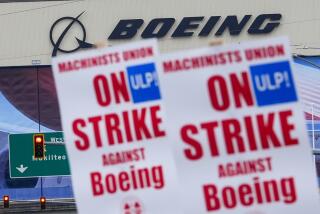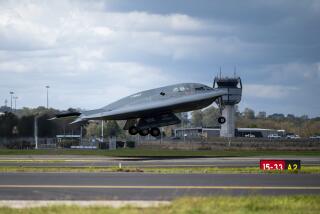Congressional Battle Over B-2 Stealth Bomber Heads for a Showdown : Budget: Foes of the costly aircraft built in Palmdale fire the first round as the struggle for ’92 funding begins.
- Share via
WASHINGTON — A key House subcommittee’s attempt to clip the wings of the B-2 Stealth bomber program has set up a possible battle on the House floor and a certain showdown in the Senate over the costly and controversial plane that is being assembled in Palmdale.
The latest skirmish over the bat-winged B-2--a perennial in the capital’s budget wars--could become a replay of last year’s drama when the House voted to cut all funds after completion of 15 planes already authorized, but the Senate subsequently restored the money.
“It looks like we may be heading for another cycle similar to what we had last year,” said Terry Clawson, a spokesman for Northrop Corp., the plane’s prime contractor.
“The Air Force has stated this is their No. 1 priority,” he said. “The President has come out very strongly in favor of the B-2. You have the experiences from the Persian Gulf, where the revolutionary aspects that Stealth can bring to warfare--putting less people in harm’s way”--were demonstrated by the radar-evading F-117 Stealth fighter.
Opponents, however, contend that the B-2’s $780-million per-plane price tag makes the bomber far too costly, and that eased superpower tensions make it largely unnecessary. The B-2 is designed to evade Soviet radar and penetrate deep into enemy territory to destroy critical targets in a nuclear war.
Although the Senate rescued the B-2 from oblivion last year, the bomber’s foes say they might have enough votes in the Senate to block funding for more planes this time around. “Each year we’ve come closer and closer,” said a spokesman for Sen. Patrick J. Leahy (D-Vt.), one of the B-2’s leading opponents. “Time is running out on this thing.”
The opening salvo in the struggle for 1992 funding was fired Tuesday, when the procurement subcommittee of the House Armed Services Committee voted 15 to 4 to terminate the B-2 program after the initial 15 planes. The panel cut $3.2 billion in procurement funds requested by President Bush in his 1992 budget proposal, while retaining $1.56 billion for continued research on Stealth technology.
Members of the subcommittee predicted that the full committee and the House would concur with the action, as they did last year. But proponents of the B-2 said Friday that the plane’s defenders may seek an amendment on the House floor to restore the money before the issue moves to the Senate--where intense debate is expected.
The plane’s backers contend that, despite the House subcommittee vote, the Persian Gulf War changed the dynamics of the issue, technologically and politically.
“Before, the argument against the B-2 was that the technology was never used and had not been tested,” said an aide to Rep. Jerry Lewis (R-Highland), whose district includes Northrop’s Palmdale plant. “But now the Stealth technology has been tested against some of the most sophisticated radar and missile sites in the world in a combat situation.”
Also, one B-2 proponent said that some Democrats who voted against authorizing President Bush to go to war to expel Iraqi forces from Kuwait might now be reluctant to add an anti-B-2 vote to their record. And Sen. Sam Nunn (D-Ga.), the influential chairman of the Senate Armed Services Committee, has vowed to go to bat for the plane again.
Leahy, however, testified last month that the B-2 program still amounts to “building planes with an enormous number of defects, without adequate testing and without any idea what the final cost will be. If rising costs and an outdated mission don’t bring the B-2 down, the American public most certainly will.”
The Air Force plans a vigorous Senate lobbying campaign, including a “Stealth Week” at Andrews Air Force Base outside Washington to show off the plane to lawmakers, officials said. In addition to $4.8 billion to build four bombers in 1992, Bush has requested $4.6 billion for seven planes in 1993.
The outcome of this year’s budget battle is particularly crucial because B-2 proponents are seeking to break the 15-plane barrier that the plane’s foes have set as a ceiling.
Initially, the B-2 program called for construction of 150 long-range bombers; under budgetary pressures, Defense Secretary Dick Cheney agreed last year to scale back to an eventual goal of 75 planes.
To date, $30 billion of a planned $62 billion has been spent on the program.
Rep. Les Aspin (D-Wis.), chairman of the House Armed Services Committee and a leading critic of the B-2, said recently that it is extremely difficult to stop an ongoing weapons program and predicted that the Stealth bomber will be slowed but not killed this year.
Northrop employs 3,000 workers at its Palmdale plant and an additional 9,000 at its Pico Rivera plant, where the B-2 program is headquartered.
A cutoff of construction funds would not have an immediate effect on employment because the money for the first 15 planes is still in the pipeline, but eventually it would mean “a big impact on those people,” company spokesman Clawson said.
More to Read
Get the L.A. Times Politics newsletter
Deeply reported insights into legislation, politics and policy from Sacramento, Washington and beyond. In your inbox twice per week.
You may occasionally receive promotional content from the Los Angeles Times.









